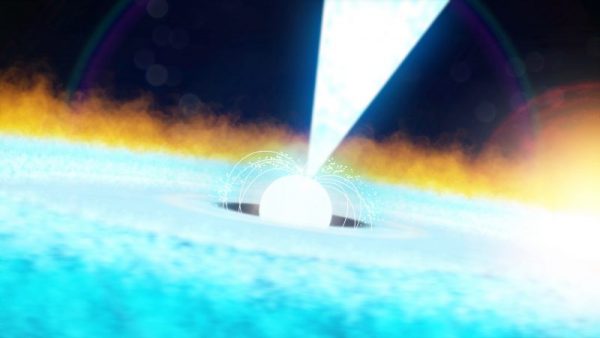Astronomers catch a record-setting X-ray burst – EarthSky
On August 20, 2019, a special telescope mounted on the outside of the International Space Station (ISS) detected a sudden spike of X-rays from a distant neutron star that’s also a pulsar. The explosion, which astronomers classify as a Type I X-ray burst, released as much energy in 20 seconds as the sun does in nearly 10 days. Turns out it was a massive thermonuclear flash on the pulsar, which is labeled J1808 by astronomers. This pulsar – the crushed remains of a star that long ago exploded as a supernova – is located about 11,400 light-years away in the direction of our constellation Sagittarius the Archer. NASA said these observations of the record-setting X-ray spike on this object:
… reveal many phenomena that have never been seen together in a single burst. In addition, the subsiding fireball briefly brightened again for reasons astronomers cannot yet explain.
The telescope aboard ISS is interesting, too. It’s called NICER, which stands for Neutron star Interior Composition Explorer, and it was launched to ISS in 2017. It has made multiple discoveries before this, but, according to lead researcher Peter Bult of NASA’s Goddard Space Flight Center and the University of Maryland:
This burst was outstanding. We see a two-step change in brightness, which we think is caused by the ejection of separate layers from the pulsar surface, and other features that will help us decode the physics of these powerful events.
A paper describing the observations and resulting analysis has been published by the peer-reviewed Astrophysical Journal Letters and is available online.
EarthSky 2020 lunar calendars are available! They make great gifts. Order now. Going fast!

View larger. | Artist’s concept via NASA.
Neutron stars are highly compact stars, the crushed remains of a massive star that ran out of fuel, collapsed under its own weight, and exploded as a supernova. Pulsars are characterized by their rapid spin and – in the case of X-ray pulsars – by the X-ray-emitting hot spots at their magnetic poles. As the object spins, it sweeps the hot spots across our line of sight, producing regular pulses of high-energy radiation. We observe the pulses, and so call the object a pulsar. NASA explained that J1808:
… spins at a dizzying 401 rotations each second, and is one member of a binary system. Its companion is a brown dwarf, an object larger than a giant planet yet too small to be a star. A steady stream of hydrogen gas flows from the companion toward the neutron star, and it accumulates in a vast storage structure called an accretion disk.
Gas in accretion disks doesn’t move inward easily. But every few years, the disks around pulsars like J1808 become so dense that a large amount of the gas becomes ionized, or stripped of its electrons. This makes it more difficult for light to move through the disk. The trapped energy starts a runaway process of heating and ionization that traps yet more energy. The gas becomes more resistant to flow and starts spiraling inward, ultimately falling onto the pulsar.
Hydrogen raining onto the surface forms a hot, ever-deepening global ‘sea.’ At the base of this layer, temperatures and pressures increase until hydrogen nuclei fuse to form helium nuclei, which produces energy – a process at work in the core of our sun.
Zaven Arzoumanian, who is deputy PI for NICER and a co-author on the new paper, said:
The helium settles out and builds up a layer of its own. Once the helium layer is a few meters deep, the conditions allow helium nuclei to fuse into carbon. Then the helium erupts explosively and unleashes a thermonuclear fireball across the entire pulsar surface.
Hence, the X-ray spike.
These astronomers said a concept called the Eddington limit – named for English astrophysicist Sir Arthur Eddington – also comes into play here. The Eddington limit is a theoretical upper limit to the mass of a star, or, as these astronomers described it:
… the maximum radiation intensity a star can have before that radiation causes the star to expand. This point depends strongly on the composition of the material lying above the emission source.
Co-author Deepto Chakrabarty of MIT said:
Our study exploits this longstanding concept in a new way. We are apparently seeing the Eddington limit for two different compositions in the same X-ray burst. This is a very powerful and direct way of following the nuclear burning reactions that underlie the event.
In other words, as the burst started, NICER data showed that its X-ray brightness leveled off for almost a second, and then increased again at a slower pace. NASA said:
The researchers interpret this ‘stall’ as the moment when the energy of the blast built up enough to blow the pulsar’s hydrogen layer into space.
The fireball continued to build for another two seconds and then reached its peak, blowing off the more massive helium layer. The helium expanded faster, overtook the hydrogen layer before it could dissipate, and then slowed, stopped and settled back down onto the pulsar’s surface.
Following this phase, the pulsar briefly brightened again by roughly 20 percent for reasons the team does not yet understand.
The NICER telescope has provided other cool insights about the exotic objects in our Milky Way galaxy. Visit NICER’s website. Or check out the two videos below. The first is an overview of NICER and what its makers expect it to provide, in terms of insights about neutron stars. The second is a fun video timelapse, showing NICER twisting and turning from its perch on the hull of ISS.
Bottom line: In August, NASA’s NICER telescope aboard ISS observed a sudden spike of X-rays from a neutron star, or pulsar. The star released as much energy in 20 seconds as our sun does in nearly 10 days. Turns out it was a massive thermonuclear flash on a pulsar, the crushed remains of a star that exploded as a supernova long ago.
Source: A NICER Thermonuclear Burst from the Millisecond X-Ray Pulsar SAX J1808.4–3658






